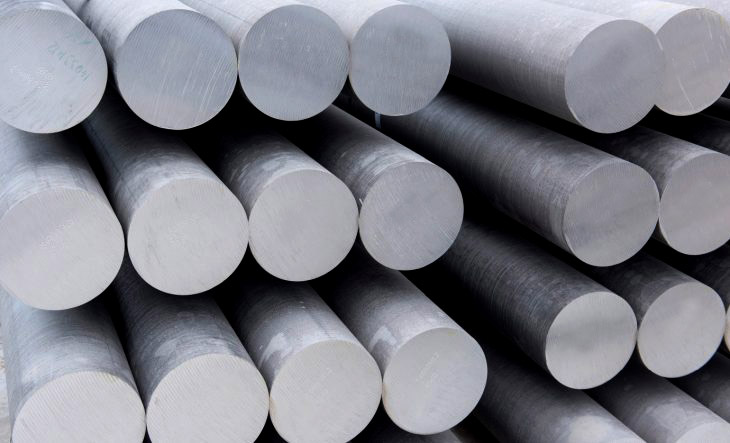Aluminum
Aluminum Supply and Production
Aluminum is the most abundant metal element found within the earth and is one of the most widely used metals around the world. It is a little-known fact that in the early 1800s when aluminum was discovered, it was one of the most expensive metals in the world despite there being so much of it. The natural form of aluminum, Aluminum Sulfate, is only found in combination with other minerals such as sulfur, silicon, and titanium. During the early 1800s, the process of extracting aluminum for these other elements had not been found yet. For that reason, the rarity of pure aluminum made it so valuable that it was once worth more than gold.
The pure metal alloy we know today as aluminum is chemically refined through two-processes known as the Bayer process and the Hall-Heroult process. The combination of the natural physical properties of aluminum and the refining process it goes through makes this metal super light, extremely durable, malleable, non-corrosive, and most importantly, 100% recyclable.
Once refined, aluminum can be combined with other materials to make several alloys with different attributes depending on its intended use. Because of the versatility of aluminum, you can find this alloy being used in just about everything from consumer goods to aerospace manufacturing, transportation, and industrial and architectural construction.
Where Aluminum Comes From
Contrary to popular belief, aluminum isn’t just pulled out of a mine as a finished product. Aluminum is found in all types of clay, but most of the aluminum being used today is taken from the ground as bauxite ore. Bauxite ore is a reddish-like rock formed from clay and is mostly found in tropical or subtropical regions like Australia, Brazil, India, Guinea. Bauxite ore consists of aluminum oxide, iron oxide, and silica. Once mined these elements need to be separated and refined through two chemical processing phases to get pure aluminum.
The Bayer Process
In phase one, bauxite ore goes through a four-step process called the Bayer process where the bauxite ore is refined into aluminum oxide. This process was developed by Carl Bayer and uses a solution of sodium hydroxide and extreme heat in a pressure vacuum to extract and dissolve the aluminum oxide which is then heat-treated to get the alumina.
The Hall-Heroult Process
In phase two, the refined alumina is smelted into pure aluminum using the Hall-Heroult Process. In this phase of the process, developed by Charles Martin Hall and Paul Héroult, alumina is placed into a large reduction pot with powerful electric currents to produce the final product of 99.8% pure aluminum. The success and effectiveness of the Hall-Heroult Process ultimately led to the founding of the Pittsburgh Reduction Company, which was the first commercial aluminum plant in American.
The Recycling Processes
Aluminum is 100% recyclable. In fact, almost 75 percent of the aluminum that has ever been made is still being used today and almost 40 percent of the aluminum supply used in North America these days is recycled aluminum, according to The Aluminum Association. The process of recycling aluminum extends its life and creates a much stronger material when melted down and remanufactured into a new product.
Aluminum Alloys
While aluminum is popular in its pure form, it is also an excellent material to form other metal alloys. Aluminum Alloy is a chemical compound of pure aluminum and other elements that will enhance the physical properties of the final product. Aluminum can be mixed with copper, magnesium, manganese, silicon, zinc or other materials to form different types of alloys. Each alloy has its own set of unique properties that are identified by a four-digit number. This assigned number is used to easily identify the characteristics of the alloy. For example, there are very strong alloys, like 1100, 2014, and 7075, there are highly formable and weldable alloys like 5052 and 6061, 6063 and there are corrosion-resistant alloys like 2124 as well.
Types of Aluminum Products
Aluminum’s popularity doesn’t stop at its ability to mix with other materials, it’s also widely appreciated for its malleability and ductility. Aluminum can be molded, welded, and pressed into several shapes like beams, rods, and bars to build strong and light structures. Aluminum can also be flattened into sheets and used to make signs or used as the skin for boats or aircraft. One of the most popular types of aluminum is extruded aluminum.
Aluminum extrusion involves heating a log of aluminum called a billet and pushing it through a heated metal plate, called a die, under high pressure to create a long length of that shape. This method of extruding aluminum can be used to create aluminum channels, Z Clips, aluminum angles, aluminum bars, aluminum J caps, aluminum extrusions for architectural millwork, store fixtures, and store displays and aluminum extrusions for custom and OEM manufacturing. The advantages of this process include the ability to make large, continuous pieces and to form pieces into basically any shape of cross-section you desire.
Custom and OEM Aluminum Extrusions From Eagle Aluminum
Eagle Aluminum is a manufacturer, stocking warehouse, and supplier of custom and OEM aluminum extrusions. If we don’t have the extruded aluminum part that meets your specifications, our professionals will help you create and engineer one to meet your needs. Our custom and OEM extrusion services enable us to meet nearly any aluminum extrusion needs our customers may have. Contact our experienced customer service team today.


